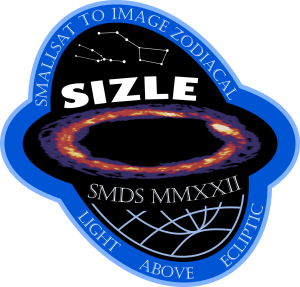 SIZLE: SmallSat to Image Zodiacal Light Above Ecliptic
SIZLE: SmallSat to Image Zodiacal Light Above Ecliptic
SIZLE will use a solar sail to maneuver into a 1AU circular orbit, inclined 30 degrees above the ecliptic plane. We will then image the zodiacal dust cloud to determine its structure and size.
Sponsors + Partner Organizations
We are very thankful for the following organizations for making this summer’s program possible!

Science Background: What is Zodiacal Light?

Interplanetary dust grains intercept and reprocess a small fraction of the solar radiation in scattered light and thermal emission. The result: the most luminous source in solar system after the sun (two orders of magnitude brighter than all the planets!). To date, our knowledge of the distribution of dust is very limited. Increasing our understanding of the asymmetries and concentrations can better inform solar system missions as collisions with this dust damage spacecraft.
Studies have shown that there are structures (dust bands, asymmetries) that result from both production mechanisms and dynamical evolution of the dust. The dust observed so far is determined to be and a mix of asteroidal and cometary in origin, but the distribution of dust beyond the astertoid belt remains largely an open question.
Mission Motivation:

No mission with imaging capability has ever left the ecliptic plane to image the zodiacal light from above. The high surface brightness of zodiacal light requires only a small aperture with moderate sensitivity. The following science goals can therefore be met with a small camera inserted into an inclined heliocentric orbit that reaches > 0.1 AU above the ecliptic plane.
Science Goals:
The SIZLE mission seeks to:
- Determine the structure of the zodiacal dust bands between Earth
and Jupiter. - Distinguish between dust bands within the total observed zodiacal
dust. - Determine which planetary objects replenish each dust band.
- Determine the dynamics of the zodiacal dust between the Earth and Jupiter.
Relevance to NASA: SIZLE addresses the following questions from the Decadal Strategy for Planetary Science and Astrobiology 2023 – 2032
-
-
- Which bodies and processes produce the smallest particles in our solar system and how do these particles evolve?
- How have collisions affected the evolution and properties of planetary bodies?
-
Mission Quad Chart
Science Traceability Matrix
Science Instrument: